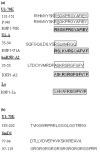Importance of spliceosomal RNP1 motif for intermolecular T-B cell spreading and tolerance restoration in lupus
- PMID: 17963484
- PMCID: PMC2212579
- DOI: 10.1186/ar2317
Importance of spliceosomal RNP1 motif for intermolecular T-B cell spreading and tolerance restoration in lupus
Abstract
We previously demonstrated the importance of the RNP1 motif-bearing region 131-151 of the U1-70K spliceosomal protein in the intramolecular T-B spreading that occurs in MRL/lpr lupus mice. Here, we analyze the involvement of RNP1 motif in the development and prevention of naturally-occurring intermolecular T-B cell diversification. We found that MRL/lpr peripheral blood lymphocytes proliferated in response to peptides containing or corresponding exactly to the RNP1 motif of spliceosomal U1-70K, U1-A and hnRNP-A2 proteins. We also demonstrated that rabbit antibodies to peptide 131-151 cross-reacted with U1-70K, U1-A and hnRNP-A2 RNP1-peptides. These antibodies recognized the U1-70K and U1-A proteins, and also U1-C and SmD1 proteins, which are devoid of RNP1 motif. Repeated administration of phosphorylated peptide P140 into MRL/lpr mice abolished T-cell response to several peptides from the U1-70K, U1-A and SmD1 proteins without affecting antibody and T-cell responses to foreign (viral) antigen in treated mice challenged with infectious virus. These results emphasized the importance of the dominant RNP1 region, which seems to be central in the activation cascade of B and T cells reacting with spliceosomal RNP1+ and RNP1- spliceosomal proteins. The tolerogenic peptide P140, which is recognized by lupus patients' CD4+ T cells and known to protect MRL/lpr mice, is able to thwart emergence of intermolecular T-cell spreading in treated animals.
Figures






Similar articles
-
Intramolecular T cell spreading in unprimed MRL/lpr mice: importance of the U1-70k protein sequence 131-151.Arthritis Rheum. 2004 Oct;50(10):3232-8. doi: 10.1002/art.20510. Arthritis Rheum. 2004. PMID: 15476231
-
Murine models of systemic lupus erythematosus: B and T cell responses to spliceosomal ribonucleoproteins in MRL/Fas(lpr) and (NZB x NZW)F(1) lupus mice.Int Immunol. 2001 Sep;13(9):1155-63. doi: 10.1093/intimm/13.9.1155. Int Immunol. 2001. PMID: 11526096
-
[The spliceosome and its interest for lupus therapy].Rev Med Interne. 2007 Oct;28(10):725-8. doi: 10.1016/j.revmed.2007.05.003. Epub 2007 May 22. Rev Med Interne. 2007. PMID: 17553599 French.
-
Key sequences involved in the spreading of the systemic autoimmune response to spliceosomal proteins.Scand J Immunol. 2001 Jul-Aug;54(1-2):45-54. doi: 10.1046/j.1365-3083.2001.00942.x. Scand J Immunol. 2001. PMID: 11439147 Review.
-
The central and multiple roles of B cells in lupus pathogenesis.Immunol Rev. 1999 Jun;169:107-21. doi: 10.1111/j.1600-065x.1999.tb01310.x. Immunol Rev. 1999. PMID: 10450512 Review.
Cited by
-
HSC70 blockade by the therapeutic peptide P140 affects autophagic processes and endogenous MHCII presentation in murine lupus.Ann Rheum Dis. 2011 May;70(5):837-43. doi: 10.1136/ard.2010.139832. Epub 2010 Dec 20. Ann Rheum Dis. 2011. PMID: 21173017 Free PMC article.
-
In Vivo Remodeling of Altered Autophagy-Lysosomal Pathway by a Phosphopeptide in Lupus.Cells. 2020 Oct 20;9(10):2328. doi: 10.3390/cells9102328. Cells. 2020. PMID: 33092174 Free PMC article.
-
The spliceosomal phosphopeptide P140 controls the lupus disease by interacting with the HSC70 protein and via a mechanism mediated by gammadelta T cells.PLoS One. 2009;4(4):e5273. doi: 10.1371/journal.pone.0005273. Epub 2009 Apr 23. PLoS One. 2009. PMID: 19390596 Free PMC article.
-
B Cell Metabolism and Autophagy in Autoimmunity.Front Immunol. 2021 Jun 7;12:681105. doi: 10.3389/fimmu.2021.681105. eCollection 2021. Front Immunol. 2021. PMID: 34163480 Free PMC article. Review.
-
Manipulating autophagic processes in autoimmune diseases: a special focus on modulating chaperone-mediated autophagy, an emerging therapeutic target.Front Immunol. 2015 May 19;6:252. doi: 10.3389/fimmu.2015.00252. eCollection 2015. Front Immunol. 2015. PMID: 26042127 Free PMC article. Review.
References
-
- Dumortier H, Monneaux F, Jahn-Schmid B, Briand JP, Skriner K, Cohen PL, Smolen JS, Steiner G, Muller S. B and T cell responses to the spliceosomal heterogeneous nuclear ribonucleoproteins A2 and B1 in normal and lupus mice. J Immunol. 2000;165:2297–2305. - PubMed
Publication types
MeSH terms
Substances
LinkOut - more resources
Full Text Sources
Other Literature Sources
Medical
Research Materials

